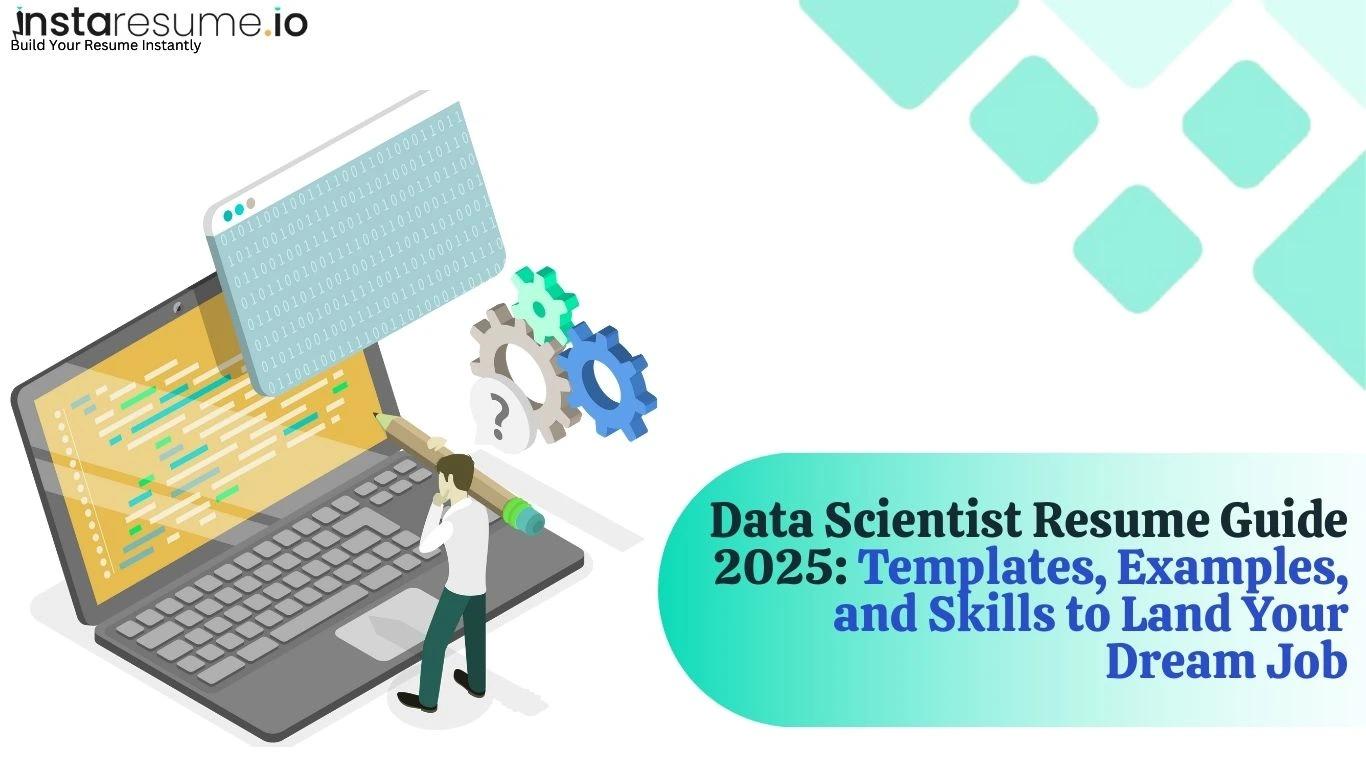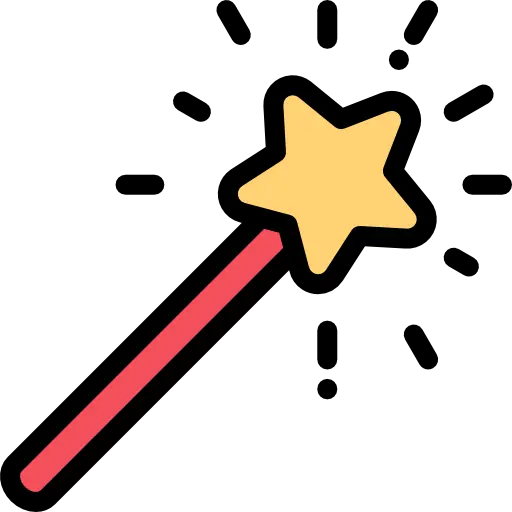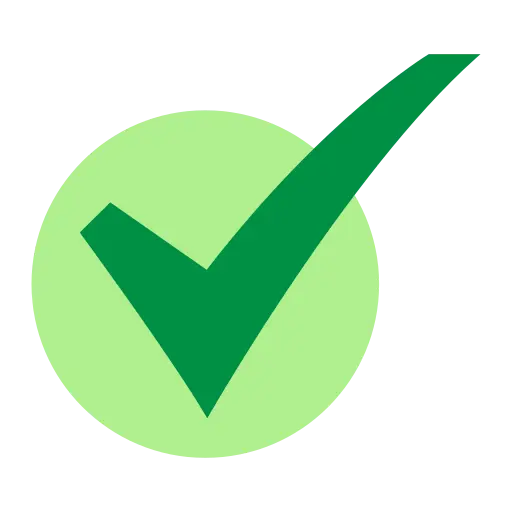Data Scientist Resume Guide 2025: Templates, Examples, and Skills to Land Your Dream Job
Trust Score: 4.8
356 reviews

Table of Contents
Introduction
A career in data science has become one of the most competitive and rewarding paths in 2025. With companies across industries leveraging artificial intelligence, machine learning, and big data to make smarter decisions, the demand for skilled data scientists is at an all-time high. But while the opportunities are abundant, the competition is equally fierce — meaning your resume must stand out to land interviews at top organizations.
Why a Strong Data Scientist Resume Matters in 2025
Your resume is more than just a list of skills and experiences; it’s your personal marketing tool. Recruiters and hiring managers receive hundreds of applications for a single data science role, and most resumes are first scanned by Applicant Tracking Systems (ATS). A strong, ATS-friendly data scientist resume ensures your profile gets noticed, highlights your technical expertise (Python, SQL, ML, AI, etc.), and shows the impact you’ve made through real-world projects.
What Recruiters Look for in Data Science Resumes
Hiring managers want more than just technical skills — they seek candidates who can solve business problems with data-driven insights. This means they’re scanning your resume for:
 Relevant technical skills (programming, statistics, ML, AI, cloud tools)
Relevant technical skills (programming, statistics, ML, AI, cloud tools) Practical project experience (real datasets, case studies, portfolio links)
Practical project experience (real datasets, case studies, portfolio links) Business impact (quantifiable results, such as accuracy improvements, cost savings, or efficiency gains)
Business impact (quantifiable results, such as accuracy improvements, cost savings, or efficiency gains) Clear communication (ability to translate complex data into actionable insights)
Clear communication (ability to translate complex data into actionable insights)
In short, the ideal data scientist resume combines technical proficiency, problem-solving ability, and business impact in a clean, ATS-optimized format.
Data Scientist Resume Examples That Work in 2025
When building your resume, it helps to look at real examples tailored to specific roles. Below are six ATS optimized resume examples for different data science job titles, along with insights into why these resumes are effective and which Instaresume AI Resume Builder template suits them best.
1. Entry-Level Data Scientist Resume Example
Why it works:
 Focuses on educational background, internships, and academic projects.
Focuses on educational background, internships, and academic projects. Highlights technical skills like Python, SQL, and machine learning, even with limited work experience.
Highlights technical skills like Python, SQL, and machine learning, even with limited work experience. Uses concise bullet points to showcase project outcomes (e.g., “Improved model accuracy by 12% in a predictive analysis project”).
Uses concise bullet points to showcase project outcomes (e.g., “Improved model accuracy by 12% in a predictive analysis project”).
Template Used: Modern Clean Template – perfect for freshers and students as it balances skills and education sections with clarity.
2. Experienced Data Scientist Resume Example
Why it works:
 Emphasizes work achievements over responsibilities.
Emphasizes work achievements over responsibilities. Uses metrics to demonstrate business impact (e.g., “Reduced customer churn by 20% using predictive analytics”).
Uses metrics to demonstrate business impact (e.g., “Reduced customer churn by 20% using predictive analytics”). ATS-optimized with the right keywords like big data, cloud computing, deep learning.
ATS-optimized with the right keywords like big data, cloud computing, deep learning.
Template Used: Professional Corporate Template – ideal for mid to senior professionals applying in established organizations.
3. Data Scientist Resume for Career Switchers
Why it works:
 Highlights transferable skills from previous roles (e.g., analytics, problem-solving, data visualization).
Highlights transferable skills from previous roles (e.g., analytics, problem-solving, data visualization). Showcases certifications (Google Data Analytics, IBM Data Science) to validate expertise.
Showcases certifications (Google Data Analytics, IBM Data Science) to validate expertise. Includes a strong summary that explains the career transition clearly.
Includes a strong summary that explains the career transition clearly.
Template Used: Hybrid Functional Template – great for those with diverse experience, giving more weight to skills and certifications.
4. Machine Learning Engineer Resume Example
Why it works:
 Strong technical section with focus on ML algorithms, TensorFlow, PyTorch, and model deployment.
Strong technical section with focus on ML algorithms, TensorFlow, PyTorch, and model deployment. Project portfolio links included (GitHub, Kaggle).
Project portfolio links included (GitHub, Kaggle). Quantifies impact (e.g., “Deployed recommendation system that boosted sales by 15%”).
Quantifies impact (e.g., “Deployed recommendation system that boosted sales by 15%”).
Template Used: Tech-Oriented Minimalist Template – highlights technical expertise while keeping design clean and recruiter-friendly.
5. Data Analyst to Data Scientist Resume Example
Why it works:
 Bridges the gap by showcasing analytics experience while adding new data science skills.
Bridges the gap by showcasing analytics experience while adding new data science skills. Focuses on visualization tools (Tableau, Power BI) along with ML basics.
Focuses on visualization tools (Tableau, Power BI) along with ML basics. Shows progression from reporting tasks to predictive modeling.
Shows progression from reporting tasks to predictive modeling.
Template Used: Career Growth Template – emphasizes career trajectory and skill evolution, ideal for professionals moving up the ladder.
6. Academic/Research Data Scientist Resume Example
Why it works:
 Highlights research publications, academic projects, and teaching experience.
Highlights research publications, academic projects, and teaching experience. Strong emphasis on statistical modeling and advanced methods.
Strong emphasis on statistical modeling and advanced methods. Includes conference presentations and journal contributions.
Includes conference presentations and journal contributions.
Template Used: Academic Research Template – designed for candidates applying in universities, think tanks, or R&D labs.
👉 Why These Resume Examples Work:
Each example is designed with ATS optimization, clear formatting, and tailored keywords in mind. By aligning your resume with the right job title and template, you increase your chances of standing out to recruiters and landing interviews faster.
With Instaresume AI Resume Builder, you can select a template based on your career stage, input your details, and let AI enhance the wording and structure for maximum recruiter impact.
How to Write Each Section of Your Data Scientist Resume (Step-by-Step Guide)
A resume is only as strong as the details you put into each section. Below is a breakdown of every resume section with actionable tips to help you create a professional, ATS-friendly data scientist resume that stands out.
1. Contact Information
What to Include:
 Full name
Full name Phone number
Phone number Professional email ID (avoid casual addresses)
Professional email ID (avoid casual addresses) LinkedIn profile & GitHub/portfolio links
LinkedIn profile & GitHub/portfolio links
Tips:
 Don’t add unnecessary details like marital status or full address.
Don’t add unnecessary details like marital status or full address. A portfolio/GitHub link can make a big difference for data science roles.
A portfolio/GitHub link can make a big difference for data science roles.
2. Resume Summary or Objective
For Freshers/Entry-Level: Write an objective that highlights education, certifications, and projects.
For Experienced Candidates: Write a summary that emphasizes key achievements and career highlights.
Tips:
 Keep it 3–4 sentences maximum.
Keep it 3–4 sentences maximum. Add keywords like machine learning, big data, predictive analytics.
Add keywords like machine learning, big data, predictive analytics. Example: “Data Scientist with 5+ years of experience in predictive modeling and NLP, improving model accuracy by 20% and reducing operational costs for Fortune 500 companies.”
Example: “Data Scientist with 5+ years of experience in predictive modeling and NLP, improving model accuracy by 20% and reducing operational costs for Fortune 500 companies.”
3. Skills Section
Hard Skills to Highlight:
 Programming: Python, R, SQL, Java
Programming: Python, R, SQL, Java Machine Learning: TensorFlow, PyTorch, Scikit-learn
Machine Learning: TensorFlow, PyTorch, Scikit-learn Data Visualization: Tableau, Power BI, Matplotlib
Data Visualization: Tableau, Power BI, Matplotlib Big Data: Hadoop, Spark
Big Data: Hadoop, Spark Cloud Platforms: AWS, GCP, Azure
Cloud Platforms: AWS, GCP, Azure
Soft Skills to Add:
 Analytical thinking
Analytical thinking Communication skills
Communication skills Problem-solving
Problem-solving Team collaboration
Team collaboration
Tips:
 Use a two-column skill layout for better readability.
Use a two-column skill layout for better readability. Tailor skills to match the job description.
Tailor skills to match the job description.
4. Work Experience
What to Include:
 Job title, company name, duration
Job title, company name, duration 3–5 bullet points per role
3–5 bullet points per role Focus on measurable results
Focus on measurable results
Tips:
 Use action verbs (designed, developed, implemented, optimized).
Use action verbs (designed, developed, implemented, optimized). Quantify achievements: “Optimized a recommendation engine, increasing user engagement by 18%.”
Quantify achievements: “Optimized a recommendation engine, increasing user engagement by 18%.” Focus on projects & impact instead of generic responsibilities.
Focus on projects & impact instead of generic responsibilities.
5. Education
For Freshers:
 Mention degree, university, graduation year.
Mention degree, university, graduation year. Add relevant coursework (Statistics, Machine Learning, Big Data Analytics).
Add relevant coursework (Statistics, Machine Learning, Big Data Analytics).
For Experienced:
 Keep it short; highlight only highest degree & certifications.
Keep it short; highlight only highest degree & certifications.
Tips:
 Add honors, scholarships, or thesis if relevant.
Add honors, scholarships, or thesis if relevant. For Ph.D./M.Sc. candidates, highlight research projects.
For Ph.D./M.Sc. candidates, highlight research projects.
6. Projects Section
Why It Matters: Projects showcase your hands-on expertise, especially for freshers and career switchers.
What to Include:
 Title of project
Title of project Tools/technologies used
Tools/technologies used Outcome achieved
Outcome achieved
Example:
“Built a sentiment analysis model using Python & NLP, achieving 87% accuracy and applied it to real-time Twitter data.”
Tips:
 Always link GitHub or portfolio.
Always link GitHub or portfolio. Focus on real-world datasets instead of academic-only projects.
Focus on real-world datasets instead of academic-only projects.
7. Certifications (Optional but Valuable)
Best Certifications for Data Scientists:
 Google Data Analytics Certificate
Google Data Analytics Certificate IBM Data Science Professional Certificate
IBM Data Science Professional Certificate Microsoft Azure AI Fundamentals
Microsoft Azure AI Fundamentals Coursera Machine Learning (Andrew Ng)
Coursera Machine Learning (Andrew Ng)
Tips:
 Place certifications after projects if you’re a fresher.
Place certifications after projects if you’re a fresher. Only add certifications relevant to the role.
Only add certifications relevant to the role.
8. Additional Sections (If Applicable)
 Awards & Achievements (hackathons, competitions, publications)
Awards & Achievements (hackathons, competitions, publications) Languages (useful if applying to multinational companies)
Languages (useful if applying to multinational companies) Volunteer/Leadership Experience (shows teamwork & initiative)
Volunteer/Leadership Experience (shows teamwork & initiative)
👉 Final Tips for Making a Data Scientist Resume:
 Keep it one page (two if experienced).
Keep it one page (two if experienced). Optimize with job description keywords for ATS.
Optimize with job description keywords for ATS. Use Instaresume AI Resume Builder to select a template (Modern, Professional, Tech, Academic) and let AI refine phrasing, making your resume recruiter-friendly.
Use Instaresume AI Resume Builder to select a template (Modern, Professional, Tech, Academic) and let AI refine phrasing, making your resume recruiter-friendly.
Your Data Science Projects and Work Experience
Your data science projects and work experience section is the heart of your resume. Recruiters don’t just want a list of tools — they want proof that you can apply those tools to solve real-world business problems. Whether you’re an entry-level candidate or a senior professional, showcasing your projects with measurable outcomes can set you apart.
Importance of Showcasing Real-World Projects
 Real-world projects demonstrate that you can go beyond theory and apply skills like Python, SQL, machine learning, and data visualization to solve practical problems.
Real-world projects demonstrate that you can go beyond theory and apply skills like Python, SQL, machine learning, and data visualization to solve practical problems. For freshers, academic or personal projects (such as building a recommendation engine or analyzing social media sentiment) can bridge the gap between coursework and job requirements.
For freshers, academic or personal projects (such as building a recommendation engine or analyzing social media sentiment) can bridge the gap between coursework and job requirements. For experienced professionals, detailing enterprise-level data solutions (like fraud detection systems, predictive analytics for sales, or big data pipelines) highlights both technical depth and business impact.
For experienced professionals, detailing enterprise-level data solutions (like fraud detection systems, predictive analytics for sales, or big data pipelines) highlights both technical depth and business impact.
How to Describe Your Impact Using Metrics
Hiring managers love numbers. Instead of saying “Worked on a churn prediction model”, quantify the results:
 “Developed a customer churn model that reduced attrition by 12% and saved $250K annually.”
“Developed a customer churn model that reduced attrition by 12% and saved $250K annually.” “Automated data pipeline with Apache Spark, cutting processing time by 40%.”
“Automated data pipeline with Apache Spark, cutting processing time by 40%.” “Optimized machine learning model accuracy from 78% to 91% using feature engineering.”
“Optimized machine learning model accuracy from 78% to 91% using feature engineering.”
👉 Using metrics not only boosts credibility but also makes your achievements more ATS- and recruiter-friendly.
Examples of Strong Work Experience Bullet Points
Here are some ATS-optimized bullet point examples for a data scientist resume:
 Designed and deployed a recommendation engine in Python, boosting customer engagement by 18%.
Designed and deployed a recommendation engine in Python, boosting customer engagement by 18%. Performed A/B testing and statistical analysis that improved conversion rate by 9% for an e-commerce platform.
Performed A/B testing and statistical analysis that improved conversion rate by 9% for an e-commerce platform. Built and visualized dashboards in Tableau, enabling leadership to cut reporting time by 30%.
Built and visualized dashboards in Tableau, enabling leadership to cut reporting time by 30%. Implemented NLP techniques for sentiment analysis on 100K+ reviews, achieving 88% accuracy.
Implemented NLP techniques for sentiment analysis on 100K+ reviews, achieving 88% accuracy.
Linking to GitHub/Kaggle Portfolios
Adding portfolio links makes your resume interactive and builds trust:
 GitHub: Upload code for machine learning projects, data pipelines, and notebooks.
GitHub: Upload code for machine learning projects, data pipelines, and notebooks. Kaggle: Showcase competition rankings, kernels, and community contributions.
Kaggle: Showcase competition rankings, kernels, and community contributions. Personal Website/Portfolio: A custom site adds credibility and highlights professionalism.
Personal Website/Portfolio: A custom site adds credibility and highlights professionalism.
Entry-Level Data Science Projects for Resume
If you’re starting your career in data science, you might not have years of work experience — but you can still create a job-winning resume by showcasing strong entry-level data science projects. Recruiters want to see how you’ve applied your skills in real scenarios, even if they were academic, personal, or community-driven projects.
Academic Projects That Matter (Capstone, Thesis, Coursework)
 Highlight major academic projects that show technical depth and problem-solving ability.
Highlight major academic projects that show technical depth and problem-solving ability. Examples:
Examples:  “Capstone Project: Built a predictive model using logistic regression to identify student dropout risks with 85% accuracy.”
“Capstone Project: Built a predictive model using logistic regression to identify student dropout risks with 85% accuracy.” “Thesis: Applied clustering algorithms on healthcare data to detect disease patterns across 10,000 patient records.”
“Thesis: Applied clustering algorithms on healthcare data to detect disease patterns across 10,000 patient records.” “Coursework Project: Developed a Tableau dashboard for visualizing economic growth trends in India from 1990–2020.”
“Coursework Project: Developed a Tableau dashboard for visualizing economic growth trends in India from 1990–2020.”
 Tip: Always connect your project to real-world outcomes, not just classroom results.
Tip: Always connect your project to real-world outcomes, not just classroom results.
Personal Projects (Sentiment Analysis, Recommendation System, Predictive Analytics)
 Personal projects prove you’re self-driven and passionate about data science.
Personal projects prove you’re self-driven and passionate about data science. Examples you can include:
Examples you can include:  Sentiment Analysis: Analyzed 50,000 tweets using NLP to gauge public opinion on climate change.
Sentiment Analysis: Analyzed 50,000 tweets using NLP to gauge public opinion on climate change. Recommendation System: Built a movie recommendation engine using collaborative filtering and deployed it on Heroku.
Recommendation System: Built a movie recommendation engine using collaborative filtering and deployed it on Heroku. Predictive Analytics: Forecasted sales trends using ARIMA models, improving prediction accuracy by 20%.
Predictive Analytics: Forecasted sales trends using ARIMA models, improving prediction accuracy by 20%.
 Tip: Upload your project notebooks/code to GitHub and add links in your resume.
Tip: Upload your project notebooks/code to GitHub and add links in your resume.
Open-Source Contributions & Hackathons
 Open-source work shows collaboration, coding quality, and community engagement.
Open-source work shows collaboration, coding quality, and community engagement. Examples:
Examples:  Contributed to scikit-learn or TensorFlow by fixing bugs or adding documentation.
Contributed to scikit-learn or TensorFlow by fixing bugs or adding documentation. Participated in Kaggle competitions, ranking in the top 15% with an image classification project.
Participated in Kaggle competitions, ranking in the top 15% with an image classification project. Joined a hackathon and developed a fraud detection tool using machine learning in under 48 hours.
Joined a hackathon and developed a fraud detection tool using machine learning in under 48 hours.
 Tip: Even small contributions in open-source projects look great on an entry-level data scientist resume.
Tip: Even small contributions in open-source projects look great on an entry-level data scientist resume.
Tips for Freshers: Focus on Skills Applied and Outcomes Achieved
 Always mention tools and technologies used (Python, R, SQL, TensorFlow, Tableau).
Always mention tools and technologies used (Python, R, SQL, TensorFlow, Tableau). Quantify your results wherever possible (accuracy, efficiency, cost savings, time reduction).
Quantify your results wherever possible (accuracy, efficiency, cost savings, time reduction). Keep bullet points action-oriented (developed, designed, implemented, automated).
Keep bullet points action-oriented (developed, designed, implemented, automated). Use ATS-friendly keywords like machine learning, predictive modeling, big data analytics, data visualization.
Use ATS-friendly keywords like machine learning, predictive modeling, big data analytics, data visualization.
Skills That Pay the Bills
The skills section in a data scientist resume is where recruiters quickly scan to decide if you’re worth shortlisting. With Applicant Tracking Systems (ATS) filtering most applications before they reach a human, listing the right hard skills and soft skills in a structured way is critical for standing out.
Hard Skills Every Data Scientist Should Include
Your hard skills should reflect the technical tools and methods most relevant to the role:
 Programming Languages: Python, R, Java, SQL, Scala
Programming Languages: Python, R, Java, SQL, Scala Machine Learning & AI: TensorFlow, PyTorch, Scikit-learn, Keras
Machine Learning & AI: TensorFlow, PyTorch, Scikit-learn, Keras Big Data Tools: Hadoop, Apache Spark, Hive
Big Data Tools: Hadoop, Apache Spark, Hive Data Visualization: Tableau, Power BI, Matplotlib, Seaborn
Data Visualization: Tableau, Power BI, Matplotlib, Seaborn Cloud Platforms: AWS, Google Cloud (GCP), Microsoft Azure
Cloud Platforms: AWS, Google Cloud (GCP), Microsoft Azure Databases: MySQL, PostgreSQL, MongoDB
Databases: MySQL, PostgreSQL, MongoDB Other Tools: Git, Docker, Kubernetes, Jupyter Notebooks
Other Tools: Git, Docker, Kubernetes, Jupyter Notebooks
Pro Tip: Don’t just list everything you know. Prioritize the tools mentioned in the job description to boost ATS ranking.
Soft Skills That Make a Difference
Recruiters don’t just want coders — they want data scientists who can communicate insights and work in teams. Add soft skills like:
 Analytical problem-solving
Analytical problem-solving Strong communication (explaining complex data to non-technical teams)
Strong communication (explaining complex data to non-technical teams) Team collaboration
Team collaboration Critical thinking & adaptability
Critical thinking & adaptability Business acumen (translating data into business outcomes)
Business acumen (translating data into business outcomes)
Example: Instead of writing just “communication skills,” you could say “skilled in presenting analytical findings to stakeholders with actionable recommendations.”
How to Arrange Skills for ATS Optimization
ATS systems often scan resumes for grouped technical categories, so organize your skills under headers instead of dumping them in one line. Example format:
Programming: Python, R, SQL
Machine Learning: TensorFlow, PyTorch, Scikit-learn
Data Visualization: Tableau, Power BI, Matplotlib
Big Data & Cloud: Apache Spark, Hadoop, AWS, GCP
This improves readability and keyword matching for both ATS bots and recruiters.
The Ideal Length & Structure for a Skills Section
 Keep it 4–6 categories with 3–5 skills each (avoid long cluttered lists).
Keep it 4–6 categories with 3–5 skills each (avoid long cluttered lists). Use bullet points or two-column layout for easy scanning.
Use bullet points or two-column layout for easy scanning. Avoid outdated tools (like MS Excel basics) unless explicitly required by the job.
Avoid outdated tools (like MS Excel basics) unless explicitly required by the job. Position the skills section after your summary if you’re entry-level, or after work experience if you’re experienced.
Position the skills section after your summary if you’re entry-level, or after work experience if you’re experienced.
👉 By combining hard skills, soft skills, and ATS-optimized grouping, your resume will highlight both technical expertise and workplace readiness — two things every recruiter looks for in a data scientist resume.
Entry-Level vs. Senior Skills Sections
Your skills section in a data scientist resume should match your level of experience. Recruiters can instantly tell if a candidate is a fresher or a senior professional by looking at the way skills are presented. Let’s break down how entry-level and senior-level data scientists should structure their skills section.
Entry-Level: Emphasize Academic Learning, Certifications, and Foundational Tools
For freshers and career switchers, the focus should be on fundamental skills, academic knowledge, and certifications that validate your expertise. Recruiters don’t expect advanced enterprise-level tools but want proof you can work with the core data science toolkit.
Example Entry-Level Skills Section
Programming & Analytics: Python, R, SQL, Excel
Machine Learning: Scikit-learn, Pandas, NumPy
Data Visualization: Tableau, Matplotlib, Seaborn
Certifications: Google Data Analytics, IBM Data Science Certificate
Why it works: It shows recruiters that while you may not have years of industry experience, you’ve invested in certifications, mastered the basics, and applied them in academic/personal projects.
Senior-Level: Focus on Advanced Tools, Leadership, and Domain Specialization
For experienced data scientists, recruiters expect to see complex tools, large-scale systems, leadership experience, and domain expertise (like finance, healthcare, or retail).
Example Senior-Level Skills Section
Programming & Big Data: Python, R, SQL, Scala, Apache Spark, Hadoop
Machine Learning & AI: TensorFlow, PyTorch, Keras, NLP, Deep Learning, Computer Vision
Cloud & Deployment: AWS, GCP, Azure, Docker, Kubernetes, ML Ops
Leadership & Domain Expertise: Project management, Stakeholder communication, Data strategy (Healthcare/Finance/Retail)
Why it works: It demonstrates mastery of enterprise-level tools, experience deploying models into production, and the ability to lead teams and drive business impact.
Examples of Both Versions (Side-by-Side)
Entry-Level Resume Skills Example:
 Python, R, SQL
Python, R, SQL Machine Learning basics (Scikit-learn, Pandas)
Machine Learning basics (Scikit-learn, Pandas) Tableau for data visualization
Tableau for data visualization Completed Google Data Analytics Certification
Completed Google Data Analytics Certification
Senior Resume Skills Example:
 Advanced ML (Deep Learning, NLP, Computer Vision)
Advanced ML (Deep Learning, NLP, Computer Vision) Big Data & Cloud (Apache Spark, Hadoop, AWS)
Big Data & Cloud (Apache Spark, Hadoop, AWS) End-to-end ML Ops (Docker, Kubernetes, CI/CD)
End-to-end ML Ops (Docker, Kubernetes, CI/CD) Leadership: Mentored 5+ junior data scientists, led enterprise AI projects
Leadership: Mentored 5+ junior data scientists, led enterprise AI projects
How Recruiters Read Skill Progression in Resumes
 Recruiters expect entry-level resumes to show learning, enthusiasm, and strong foundational skills. They look for certifications and academic projects to validate technical knowledge.
Recruiters expect entry-level resumes to show learning, enthusiasm, and strong foundational skills. They look for certifications and academic projects to validate technical knowledge. For senior-level resumes, they look for advanced tools, quantifiable achievements, and evidence of leadership or specialization in a particular industry.
For senior-level resumes, they look for advanced tools, quantifiable achievements, and evidence of leadership or specialization in a particular industry. A natural skill progression from “basic Python & ML models” to “deploying deep learning models on AWS with ML Ops pipelines” signals career growth and credibility.
A natural skill progression from “basic Python & ML models” to “deploying deep learning models on AWS with ML Ops pipelines” signals career growth and credibility.
Education Section in a Data Scientist Resume
The education section of a data scientist resume plays a different role depending on whether you’re a fresher or an experienced professional. While freshers rely heavily on academics to prove their competence, experienced data scientists can keep this section concise and focus on higher-level qualifications and specializations.
What to Include for Freshers
If you’re applying for your first data science job, your education section should be detailed and highlight your academic achievements.
What to list:
 Degree (B.Sc., B.Tech, M.Sc., M.Tech, or M.A. in Statistics, Computer Science, Data Science, Mathematics, or related fields)
Degree (B.Sc., B.Tech, M.Sc., M.Tech, or M.A. in Statistics, Computer Science, Data Science, Mathematics, or related fields) University/Institution name
University/Institution name Graduation year
Graduation year Relevant coursework (Machine Learning, Artificial Intelligence, Probability & Statistics, Data Mining, Big Data Analytics)
Relevant coursework (Machine Learning, Artificial Intelligence, Probability & Statistics, Data Mining, Big Data Analytics) GPA (if above 3.5/4.0 or equivalent)
GPA (if above 3.5/4.0 or equivalent) Academic honors, awards, or scholarships
Academic honors, awards, or scholarships
Example (Entry-Level Resume):
B.Tech in Computer Science, XYZ University, 2024
 Relevant Coursework: Machine Learning, Big Data Analytics, Probability & Statistics
Relevant Coursework: Machine Learning, Big Data Analytics, Probability & Statistics GPA: 8.7/10 | Dean’s List | Capstone Project: Predictive Sales Forecasting Model
GPA: 8.7/10 | Dean’s List | Capstone Project: Predictive Sales Forecasting Model
What to Include for Experienced Professionals
For senior data scientists, recruiters focus more on your work experience and technical achievements, so the education section can be shorter.
What to list:
 Only your highest degree (Master’s, Ph.D., or Postgraduate Diploma)
Only your highest degree (Master’s, Ph.D., or Postgraduate Diploma) Any specialization in Data Science, Machine Learning, AI, or Statistics
Any specialization in Data Science, Machine Learning, AI, or Statistics Optional: Professional affiliations (IEEE, ACM, Data Science societies)
Optional: Professional affiliations (IEEE, ACM, Data Science societies)
Example (Senior Resume):
Ph.D. in Statistics, ABC University, 2018
Master of Science in Data Analytics, DEF University, 2015
Relevance of Bootcamps, MOOCs, and Certifications
In today’s data-driven job market, bootcamps and MOOCs (Massive Open Online Courses) are highly valued, especially for freshers and career switchers. Certifications validate your skills and show recruiters your commitment to continuous learning.
Popular Certifications to Include:
 Google Data Analytics Professional Certificate
Google Data Analytics Professional Certificate IBM Data Science Professional Certificate
IBM Data Science Professional Certificate Microsoft Azure AI Fundamentals
Microsoft Azure AI Fundamentals AWS Certified Machine Learning – Specialty
AWS Certified Machine Learning – Specialty Coursera’s Machine Learning by Andrew Ng
Coursera’s Machine Learning by Andrew Ng DataCamp/edX specialized bootcamps
DataCamp/edX specialized bootcamps
Where to place them:
 Freshers: Under Education or in a separate Certifications section.
Freshers: Under Education or in a separate Certifications section. Experienced: In a Certifications section to complement your degree.
Experienced: In a Certifications section to complement your degree.
👉 Pro Tip: If you don’t have a formal degree in data science, strong certifications + practical projects can still help you build a competitive data scientist resume.
FAQs About Data Scientist Resumes
1. What should a data scientist resume look like in 2025?
A strong data scientist resume in 2025 should be clean, ATS-friendly, and keyword optimized. It must highlight projects, skills, and measurable achievements instead of just listing job duties. Recruiters prefer resumes that showcase real-world applications of machine learning, data visualization, and predictive analytics.
2. How do I write an entry-level data scientist resume with no experience?
If you’re a fresher or career switcher, focus on:
 Academic projects (capstone, thesis, coursework)
Academic projects (capstone, thesis, coursework) Personal projects (Kaggle competitions, GitHub portfolio)
Personal projects (Kaggle competitions, GitHub portfolio) Certifications and bootcamps (Google, IBM, AWS, Coursera)
Certifications and bootcamps (Google, IBM, AWS, Coursera) Transferable skills like problem-solving and statistics
Transferable skills like problem-solving and statistics
This proves your potential even without formal job experience.
3. What are the most important skills for a data scientist resume?
Top hard skills: Python, R, SQL, Machine Learning, Deep Learning, TensorFlow, PyTorch, Cloud Platforms (AWS, Azure, GCP), Big Data Tools (Hadoop, Spark).
Top soft skills: Problem-solving, Communication, Teamwork, Business Acumen.
👉 For ATS optimization, group skills under categories (Programming, ML/AI, Cloud, Data Visualization).
4. Should I include GPA in my data scientist resume?
 Yes, if you’re a fresher and your GPA is 3.5/4.0 or higher (or equivalent).
Yes, if you’re a fresher and your GPA is 3.5/4.0 or higher (or equivalent). No, if you’re experienced — recruiters care more about projects and impact than academic scores.
No, if you’re experienced — recruiters care more about projects and impact than academic scores.
5. How long should a data scientist resume be?
 Entry-level data scientist resume → 1 page (focus on skills & projects).
Entry-level data scientist resume → 1 page (focus on skills & projects). Mid to senior-level data scientist resume → 2 pages (focus on impact, leadership, advanced tools).
Mid to senior-level data scientist resume → 2 pages (focus on impact, leadership, advanced tools).
Keep it concise, quantifiable, and results-driven.
6. Should I submit my resume as PDF or Word?
Always submit your data scientist resume as a PDF unless the job description specifies otherwise. PDFs preserve formatting and are easier for recruiters to review.
7. How can I make my data scientist resume stand out?
 Use action-driven bullet points with numbers (“Reduced training time by 30% using optimized ML pipelines”).
Use action-driven bullet points with numbers (“Reduced training time by 30% using optimized ML pipelines”). Showcase a GitHub/Kaggle portfolio link.
Showcase a GitHub/Kaggle portfolio link. Add certifications and MOOCs to show continuous learning.
Add certifications and MOOCs to show continuous learning. Use a professional AI-powered template (like Instaresume’s ATS-optimized designs).
Use a professional AI-powered template (like Instaresume’s ATS-optimized designs).






